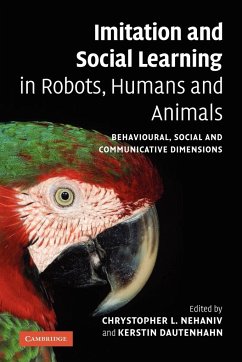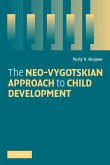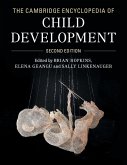Imitation and Social Learning in Robots, Humans and Animals
Behavioural, Social and Communicative Dimensions
Herausgeber: Nehaniv, Chrystopher L.; Dautenhahn, Kerstin
Imitation and Social Learning in Robots, Humans and Animals
Behavioural, Social and Communicative Dimensions
Herausgeber: Nehaniv, Chrystopher L.; Dautenhahn, Kerstin
- Broschiertes Buch
- Merkliste
- Auf die Merkliste
- Bewerten Bewerten
- Teilen
- Produkt teilen
- Produkterinnerung
- Produkterinnerung
A unique, interdisciplinary study into the field of imitation and social learning in robots, humans and animals.
Andere Kunden interessierten sich auch für
![Designing Robots, Designing Humans Designing Robots, Designing Humans]() Designing Robots, Designing Humans65,99 €
Designing Robots, Designing Humans65,99 €![Relational Psychophysics in Humans and Animals Relational Psychophysics in Humans and Animals]() Viktor SarrisRelational Psychophysics in Humans and Animals80,99 €
Viktor SarrisRelational Psychophysics in Humans and Animals80,99 €![The Neo-Vygotskian Approach to Child Development The Neo-Vygotskian Approach to Child Development]() Yuriy V. KarpovThe Neo-Vygotskian Approach to Child Development49,99 €
Yuriy V. KarpovThe Neo-Vygotskian Approach to Child Development49,99 €![Adolescent Mothers in Later Life Adolescent Mothers in Later Life]() Frank F. Jr. FurstenbergAdolescent Mothers in Later Life51,99 €
Frank F. Jr. FurstenbergAdolescent Mothers in Later Life51,99 €![The Transition to Parenthood The Transition to Parenthood]() Gerald Y. MichaelsThe Transition to Parenthood52,99 €
Gerald Y. MichaelsThe Transition to Parenthood52,99 €![Infants' Sense of People Infants' Sense of People]() Maria LegersteeInfants' Sense of People51,99 €
Maria LegersteeInfants' Sense of People51,99 €![The Cambridge Encyclopedia of Child Development The Cambridge Encyclopedia of Child Development]() The Cambridge Encyclopedia of Child Development229,99 €
The Cambridge Encyclopedia of Child Development229,99 €-
-
-
A unique, interdisciplinary study into the field of imitation and social learning in robots, humans and animals.
Hinweis: Dieser Artikel kann nur an eine deutsche Lieferadresse ausgeliefert werden.
Hinweis: Dieser Artikel kann nur an eine deutsche Lieferadresse ausgeliefert werden.
Produktdetails
- Produktdetails
- Verlag: Cambridge University Press
- Seitenzahl: 508
- Erscheinungstermin: 31. Dezember 2008
- Englisch
- Abmessung: 229mm x 152mm x 30mm
- Gewicht: 817g
- ISBN-13: 9780521108638
- ISBN-10: 0521108632
- Artikelnr.: 26488746
- Herstellerkennzeichnung
- Produktsicherheitsverantwortliche/r
- Europaallee 1
- 36244 Bad Hersfeld
- gpsr@libri.de
- Verlag: Cambridge University Press
- Seitenzahl: 508
- Erscheinungstermin: 31. Dezember 2008
- Englisch
- Abmessung: 229mm x 152mm x 30mm
- Gewicht: 817g
- ISBN-13: 9780521108638
- ISBN-10: 0521108632
- Artikelnr.: 26488746
- Herstellerkennzeichnung
- Produktsicherheitsverantwortliche/r
- Europaallee 1
- 36244 Bad Hersfeld
- gpsr@libri.de
Introduction: The constructive interdisciplinary viewpoint for
understanding mechanisms and models of imitation and social learning
Kerstin Dautenhahn and Chrystopher L. Nehaniv; Part I. Correspondence
Problems and Mechanisms: 1. Imitation: thoughts about theories Geoffrey
Bird and Cecilia Heyes; 2. Nine billion correspondence problems Chrystopher
L. Nehaniv; 3. Challenges and issues faced in building a framework for
conducting research in learning from observation Darrin Bentivegna,
Christopher Atkeson and Gordon Cheng; Part II. Mirroring and
'Mind-Reading': 4. A neural architecture for imitation and intentional
relations Marco Iacoboni, Jonas Kaplan and Stephen Wilson; 5. Simulation
theory of understanding others: a robotics perspective Yiannis Demiris and
Matthew Johnson; 6. Mirrors and matchings: imitation from the perspective
of mirror-self-recognition and the parietal region's involvement in both
Robert W. Mitchell; Part III. What to Imitate: 7. The question of 'what to
imitate': inferring goals and intentions from demonstrations Malinda
Carpenter and Josep Call; 8. Learning of gestures by imitation in a
humanoid robot Sylvain Calinon and Aude Billard; 9. The dynamic emergence
of categories through imitation Tony Belpaeme, Bart de Boer and Bart
Jansen; Part IV. Development and Embodiment: 10. Copying strategies by
people with autistic spectrum disorder: why only imitation leads to social
cognitive development Justin H. G. Williams; 11. A bayesian model of
imitation in infants and robots Rajesh P. N. Rao, Aaron P. Shon and Andrew
N. Meltzoff; 12. Solving the correspondence problem in robotic imitation
across embodiments: synchrony, perception and culture in artefacts Aris
Alissandrakis, Chrystopher L. Nehaniv and Kerstin Dautenhahn; Part V.
Synchrony and Turn-Taking as Communicative Mechanisms: 13. How to build an
imitator? Arnaud Revel and Jacqueline Nadel; 14. Simulated turn-taking and
development of styles of motion Takashi Ikegami and Hiroki Iizuka; 15.
Bullying behaviour, empathy and imitation: an attempted synthesis Kerstin
Dautenhahn, Sarah N. Woods and Christina Kaouri; Part VI. Why Imitate?
Motivations: 16. Multiple motivations for imitation in infancy Mark Nielsen
and Virginia Slaughter; 17. The progress drive hypothesis: an
interpretation of early imitation Frédéric Kaplan and Pierre-Yves Oudeyer;
Part VII. Social Feedback: 18. Training behaviour by imitation: from
parrots to people ... to robots? Irene M. Pepperberg and Diane V. Sherman;
19. Task learning through imitation and human-robot interaction Monica N.
Nicolescu and Maja J. Mataric; Part VIII. The Ecological Context: 20.
Emulation learning: the integration of technical and social cognition
Ludwig Huber; 21. Mimicry as deceptive resemblance: beyond the one-trick
ponies Mark D. Norman and Tom Tregenza.
understanding mechanisms and models of imitation and social learning
Kerstin Dautenhahn and Chrystopher L. Nehaniv; Part I. Correspondence
Problems and Mechanisms: 1. Imitation: thoughts about theories Geoffrey
Bird and Cecilia Heyes; 2. Nine billion correspondence problems Chrystopher
L. Nehaniv; 3. Challenges and issues faced in building a framework for
conducting research in learning from observation Darrin Bentivegna,
Christopher Atkeson and Gordon Cheng; Part II. Mirroring and
'Mind-Reading': 4. A neural architecture for imitation and intentional
relations Marco Iacoboni, Jonas Kaplan and Stephen Wilson; 5. Simulation
theory of understanding others: a robotics perspective Yiannis Demiris and
Matthew Johnson; 6. Mirrors and matchings: imitation from the perspective
of mirror-self-recognition and the parietal region's involvement in both
Robert W. Mitchell; Part III. What to Imitate: 7. The question of 'what to
imitate': inferring goals and intentions from demonstrations Malinda
Carpenter and Josep Call; 8. Learning of gestures by imitation in a
humanoid robot Sylvain Calinon and Aude Billard; 9. The dynamic emergence
of categories through imitation Tony Belpaeme, Bart de Boer and Bart
Jansen; Part IV. Development and Embodiment: 10. Copying strategies by
people with autistic spectrum disorder: why only imitation leads to social
cognitive development Justin H. G. Williams; 11. A bayesian model of
imitation in infants and robots Rajesh P. N. Rao, Aaron P. Shon and Andrew
N. Meltzoff; 12. Solving the correspondence problem in robotic imitation
across embodiments: synchrony, perception and culture in artefacts Aris
Alissandrakis, Chrystopher L. Nehaniv and Kerstin Dautenhahn; Part V.
Synchrony and Turn-Taking as Communicative Mechanisms: 13. How to build an
imitator? Arnaud Revel and Jacqueline Nadel; 14. Simulated turn-taking and
development of styles of motion Takashi Ikegami and Hiroki Iizuka; 15.
Bullying behaviour, empathy and imitation: an attempted synthesis Kerstin
Dautenhahn, Sarah N. Woods and Christina Kaouri; Part VI. Why Imitate?
Motivations: 16. Multiple motivations for imitation in infancy Mark Nielsen
and Virginia Slaughter; 17. The progress drive hypothesis: an
interpretation of early imitation Frédéric Kaplan and Pierre-Yves Oudeyer;
Part VII. Social Feedback: 18. Training behaviour by imitation: from
parrots to people ... to robots? Irene M. Pepperberg and Diane V. Sherman;
19. Task learning through imitation and human-robot interaction Monica N.
Nicolescu and Maja J. Mataric; Part VIII. The Ecological Context: 20.
Emulation learning: the integration of technical and social cognition
Ludwig Huber; 21. Mimicry as deceptive resemblance: beyond the one-trick
ponies Mark D. Norman and Tom Tregenza.
Introduction: The constructive interdisciplinary viewpoint for
understanding mechanisms and models of imitation and social learning
Kerstin Dautenhahn and Chrystopher L. Nehaniv; Part I. Correspondence
Problems and Mechanisms: 1. Imitation: thoughts about theories Geoffrey
Bird and Cecilia Heyes; 2. Nine billion correspondence problems Chrystopher
L. Nehaniv; 3. Challenges and issues faced in building a framework for
conducting research in learning from observation Darrin Bentivegna,
Christopher Atkeson and Gordon Cheng; Part II. Mirroring and
'Mind-Reading': 4. A neural architecture for imitation and intentional
relations Marco Iacoboni, Jonas Kaplan and Stephen Wilson; 5. Simulation
theory of understanding others: a robotics perspective Yiannis Demiris and
Matthew Johnson; 6. Mirrors and matchings: imitation from the perspective
of mirror-self-recognition and the parietal region's involvement in both
Robert W. Mitchell; Part III. What to Imitate: 7. The question of 'what to
imitate': inferring goals and intentions from demonstrations Malinda
Carpenter and Josep Call; 8. Learning of gestures by imitation in a
humanoid robot Sylvain Calinon and Aude Billard; 9. The dynamic emergence
of categories through imitation Tony Belpaeme, Bart de Boer and Bart
Jansen; Part IV. Development and Embodiment: 10. Copying strategies by
people with autistic spectrum disorder: why only imitation leads to social
cognitive development Justin H. G. Williams; 11. A bayesian model of
imitation in infants and robots Rajesh P. N. Rao, Aaron P. Shon and Andrew
N. Meltzoff; 12. Solving the correspondence problem in robotic imitation
across embodiments: synchrony, perception and culture in artefacts Aris
Alissandrakis, Chrystopher L. Nehaniv and Kerstin Dautenhahn; Part V.
Synchrony and Turn-Taking as Communicative Mechanisms: 13. How to build an
imitator? Arnaud Revel and Jacqueline Nadel; 14. Simulated turn-taking and
development of styles of motion Takashi Ikegami and Hiroki Iizuka; 15.
Bullying behaviour, empathy and imitation: an attempted synthesis Kerstin
Dautenhahn, Sarah N. Woods and Christina Kaouri; Part VI. Why Imitate?
Motivations: 16. Multiple motivations for imitation in infancy Mark Nielsen
and Virginia Slaughter; 17. The progress drive hypothesis: an
interpretation of early imitation Frédéric Kaplan and Pierre-Yves Oudeyer;
Part VII. Social Feedback: 18. Training behaviour by imitation: from
parrots to people ... to robots? Irene M. Pepperberg and Diane V. Sherman;
19. Task learning through imitation and human-robot interaction Monica N.
Nicolescu and Maja J. Mataric; Part VIII. The Ecological Context: 20.
Emulation learning: the integration of technical and social cognition
Ludwig Huber; 21. Mimicry as deceptive resemblance: beyond the one-trick
ponies Mark D. Norman and Tom Tregenza.
understanding mechanisms and models of imitation and social learning
Kerstin Dautenhahn and Chrystopher L. Nehaniv; Part I. Correspondence
Problems and Mechanisms: 1. Imitation: thoughts about theories Geoffrey
Bird and Cecilia Heyes; 2. Nine billion correspondence problems Chrystopher
L. Nehaniv; 3. Challenges and issues faced in building a framework for
conducting research in learning from observation Darrin Bentivegna,
Christopher Atkeson and Gordon Cheng; Part II. Mirroring and
'Mind-Reading': 4. A neural architecture for imitation and intentional
relations Marco Iacoboni, Jonas Kaplan and Stephen Wilson; 5. Simulation
theory of understanding others: a robotics perspective Yiannis Demiris and
Matthew Johnson; 6. Mirrors and matchings: imitation from the perspective
of mirror-self-recognition and the parietal region's involvement in both
Robert W. Mitchell; Part III. What to Imitate: 7. The question of 'what to
imitate': inferring goals and intentions from demonstrations Malinda
Carpenter and Josep Call; 8. Learning of gestures by imitation in a
humanoid robot Sylvain Calinon and Aude Billard; 9. The dynamic emergence
of categories through imitation Tony Belpaeme, Bart de Boer and Bart
Jansen; Part IV. Development and Embodiment: 10. Copying strategies by
people with autistic spectrum disorder: why only imitation leads to social
cognitive development Justin H. G. Williams; 11. A bayesian model of
imitation in infants and robots Rajesh P. N. Rao, Aaron P. Shon and Andrew
N. Meltzoff; 12. Solving the correspondence problem in robotic imitation
across embodiments: synchrony, perception and culture in artefacts Aris
Alissandrakis, Chrystopher L. Nehaniv and Kerstin Dautenhahn; Part V.
Synchrony and Turn-Taking as Communicative Mechanisms: 13. How to build an
imitator? Arnaud Revel and Jacqueline Nadel; 14. Simulated turn-taking and
development of styles of motion Takashi Ikegami and Hiroki Iizuka; 15.
Bullying behaviour, empathy and imitation: an attempted synthesis Kerstin
Dautenhahn, Sarah N. Woods and Christina Kaouri; Part VI. Why Imitate?
Motivations: 16. Multiple motivations for imitation in infancy Mark Nielsen
and Virginia Slaughter; 17. The progress drive hypothesis: an
interpretation of early imitation Frédéric Kaplan and Pierre-Yves Oudeyer;
Part VII. Social Feedback: 18. Training behaviour by imitation: from
parrots to people ... to robots? Irene M. Pepperberg and Diane V. Sherman;
19. Task learning through imitation and human-robot interaction Monica N.
Nicolescu and Maja J. Mataric; Part VIII. The Ecological Context: 20.
Emulation learning: the integration of technical and social cognition
Ludwig Huber; 21. Mimicry as deceptive resemblance: beyond the one-trick
ponies Mark D. Norman and Tom Tregenza.








